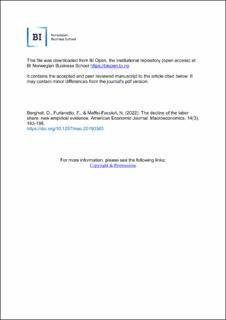| dc.contributor.author | Bergholt, Drago | |
| dc.contributor.author | Furlanetto, Francesco | |
| dc.contributor.author | Maffei Faccioli, Nicolo | |
| dc.date.accessioned | 2023-09-23T07:54:01Z | |
| dc.date.available | 2023-09-23T07:54:01Z | |
| dc.date.created | 2022-12-20T11:50:32Z | |
| dc.date.issued | 2022 | |
| dc.identifier.citation | American Economic Journal: Macroeconomics. 2022, 14 (3), 163-198. | en_US |
| dc.identifier.issn | 1945-7707 | |
| dc.identifier.uri | https://hdl.handle.net/11250/3091499 | |
| dc.description.abstract | We use time series techniques to estimate the importance of four main explanations for the decline of the US labor income share: rising firm markups, falling bargaining power of workers, higher investment-specific technology growth, and more automated production processes. Identification is achieved with restrictions derived from a stylized model of structural change. Our results point to automation as the main driver of the labor share, although rising markups have played an important role in the last 20 years. We also find evidence of capital-labor complementarity, suggesting that capital deepening may have raised the labor share. | en_US |
| dc.language.iso | eng | en_US |
| dc.publisher | American Economic Association | en_US |
| dc.title | The decline of the labor share: new empirical evidence | en_US |
| dc.title.alternative | The decline of the labor share: new empirical evidence | en_US |
| dc.type | Peer reviewed | en_US |
| dc.type | Journal article | en_US |
| dc.description.version | publishedVersion | en_US |
| dc.rights.holder | American Economic Association | en_US |
| dc.source.pagenumber | 163-198 | en_US |
| dc.source.volume | 14 | en_US |
| dc.source.journal | American Economic Journal: Macroeconomics | en_US |
| dc.source.issue | 3 | en_US |
| dc.identifier.doi | 10.1257/mac.20190365 | |
| dc.identifier.cristin | 2095638 | |
| cristin.ispublished | true | |
| cristin.fulltext | original | |
| cristin.qualitycode | 2 | |
